|

What's
new
Albas
Bourbons
Centifolias
Chinas
Climbers
Damasks
English Roses
Gallicas
Hyb. Bracteatas
Hyb. Musks
Hyb. Perpetuals
Hybrid Teas
Miniatures
Modern Shrubs
Moss Roses
Noisettes
Rugosas
Species
Teas
Site
Index
Email
|
Welcome
to the March 2001 edition of my web site! The roses I write about are
the Old Garden Roses and select shrub and miniature roses of the 20th
century.
For tips on rose culture, pruning, propagation and history, see "Other
resources on this site". To return to this page, click on the
"thorn icon" in the margin at left. Articles from the previous
months are archived and can be viewed by clicking on the listings in
the left margin. Oh, and please don't write to me for a catalog or pricelist.....this
is an information site only.....not a commercial nursery.
If you wish to buy roses, see my sponsor, The
Uncommon Rose. Thanks!
HOT
NEWS!
 I'm
sure there are many of you who are aware of Brent Dickerson's work in
unravelling the complex and often misty history of the Old Roses.
Well,
as of March 7th, 2001, the newly updated Volumes I and II of The
Old Rose Advisor are available from his publisher! The following
is quoted, in slightly edited form, from the publisher's web site: I'm
sure there are many of you who are aware of Brent Dickerson's work in
unravelling the complex and often misty history of the Old Roses.
Well,
as of March 7th, 2001, the newly updated Volumes I and II of The
Old Rose Advisor are available from his publisher! The following
is quoted, in slightly edited form, from the publisher's web site:
"This
is the improved, enlarged Second Edition of the breakthrough classic
work on reblooming old roses. It provides the most complete listing
of all of the existing or otherwise important or interesting varieties
of those opulent reblooming old roses. This improved edition of a modern
classic will be a welcome addition to the reference collection of any
lover of roses, horticulture, or horticultural history!"
Both
Volumes are available to browse by clicking on the cover images. Thank
you, Brent, for your hard work!
Pruning the Old Garden
Roses
by
Paul Barden
 It
is getting to be that time of year again, and we have to get out there
and prune the roses. For me, however, it always seems like one of the
more joyful tasks of the year, likely because it signals the oh-so-tangible
arrival of SPRING! It
is getting to be that time of year again, and we have to get out there
and prune the roses. For me, however, it always seems like one of the
more joyful tasks of the year, likely because it signals the oh-so-tangible
arrival of SPRING!
At
left: 'Erinnerung an Brod', a climber.
There
are major differences in how to approach pruning of the Old Garden Roses,
as opposed to Hybrid Teas and other modern shrubs. This is especially
true of the once-blooming types, such as the Gallicas,
Damasks, Centifolias,
and Albas, to name a few. With these,
the single most important thing to remember is to PRUNE
AFTER THE BLOOMS HAVE FINISHED! If you remove the previous year's
wood, you are removing the blooms for the spring! It is most important
to know what type of rose you have, and to determine how to prune it
correctly. There is nothing more sad than seeing a magnificent Gallica
or Damask that has had all of its previous
year's growth cut down to stumps. I see this happen, and I think of
all the hundreds of blooms that the rose MIGHT have produced if it weren't
for a careless pruning job. Removal of the previous year's wood means
few or no blossoms!
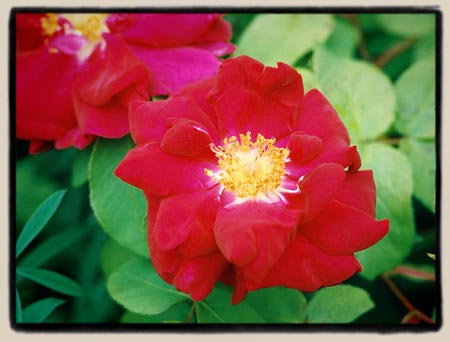 At
right: 'James Mason', a Gallica
hybrid. At
right: 'James Mason', a Gallica
hybrid.
Another important thing I like to emphasize is that the older roses
generally have their own inherent form and growth habit as they develop.
Personally, I think it is VERY important to let the rose grow WITHOUT
PRUNING for at least the first 2 years after planting. 3 years is even
better, and it will allow you the opportunity to observe how the shrub
grows before you make any decisions about how to prune it. (Naturally,
you are still going to dead-head old blossoms, and remove dead or damaged
wood) It is a good idea to allow the shrub to generate its natural infrastructure
before you start manipulating it. It's easy to start pruning a rose
when it is too young and ruin its future shape. These shrubs have been
bred to mature into a pleasant shape with a minimum of interference,
and it is wise to allow them to grow as they wish to best display this
form.
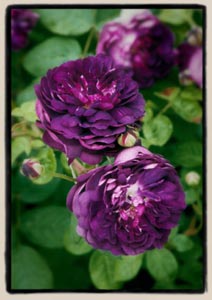 Once
Blooming varieties: The general rule is to prune these immediately after
the blooms have finished for the year. In my experience it is best to
dead-head the spent blooms (unless the rose naturally forms hips, in
which case you may want to allow these to grow) and remove some of the
oldest wood to allow the younger shoots to take over bloom production.
In many cases I find that the oldest canes eventually age to the point
where they produce fewer quality blooms, and I like to remove some of
these on a mature shrub every once in a while. With some roses, like
the Gallica 'Cardinal de Richelieu',
pictured at left, the main canes tend to be productive for 3 or 4 years,
and then should be removed to generate stronger growth. Once
Blooming varieties: The general rule is to prune these immediately after
the blooms have finished for the year. In my experience it is best to
dead-head the spent blooms (unless the rose naturally forms hips, in
which case you may want to allow these to grow) and remove some of the
oldest wood to allow the younger shoots to take over bloom production.
In many cases I find that the oldest canes eventually age to the point
where they produce fewer quality blooms, and I like to remove some of
these on a mature shrub every once in a while. With some roses, like
the Gallica 'Cardinal de Richelieu',
pictured at left, the main canes tend to be productive for 3 or 4 years,
and then should be removed to generate stronger growth.
Also,
if you are faced with the choice of either pruning a limb, or training
it horizontally instead, choose the latter option. Most of the older
roses respond extrememly well to having their long canes trained horizontally,
which translates into MUCH heavier bloom from that cane. Instead of
having a cluster of blooms from the tip of the cane, you will get multiple
clusters form at many places along the trained canes. This is something
that is often done with the climbers, (both old and new) and some of
the tall Hybrid Perpetuals and Bourbons. Another variation on this theme
is called "pegging". In this case, you simply take the long
canes and bend them down till they touch the soil, and pin them down
with wire or some other pegging device. (I usually make my own by bending
sections of heavy wire into a "U" shape) This style of training
is done with one year old canes, before they become too inflexible to
bend. As with horizontal training, the rose will produce many more blooms
along the length of the canes than it would otherwise do.
Altough
this is not technically a pruning tip, I suggest that you get out and
clean up all of last year's leaf debris. Also, remove any of last year's
foliage that might still be hanging on the plant. This helps to reduce
the Mildew and Blackspot spores in the garden, and goes a long way to
preventing these diseases during the coming season.
Here is a short
list of suggestions for pruning specific classes of the older roses:
Albas:
Many of the Albas are tall roses that display a wonderful fountain shape
as a mature shrub. It is important not to prune these until they are
at LEAST 2 years old...preferably 3! Remove any dead or damaged canes
as necessary, and thin the older, less productive wood once the plants
have reached many years age. The shorter, shrubbier varieties like Félicité
Parmentier are more upright in form, and can stand to have some
of the denser inner growth thinned to improve air circulation in the
shrub.
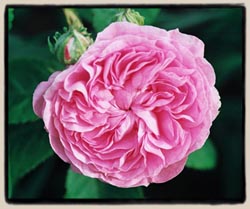 At
right: a Damask named 'La Ville
de Bruxelles' At
right: a Damask named 'La Ville
de Bruxelles'
Bourbons:
You may chose
to either leave these largely unpruned, or cut back the lateral shoots
to a few bud eyes, and shorten long new canes by 1/3. Some of the Bourbons,
such as 'Charles Lawson' are once-bloomers,
and it is best to remove only older, unproductive wood on these AFTER
they are finished blooming. The taller Bourbons, like climbing 'Souvenir
de la Malmaison' are large shrubs in habit, and need very little
pruning unless they get too unruly for their location.
Centifolias:
Treat as for Damasks, see below.
Chinas:
The Chinas are slow to develop to maturity, and tend to build wood gradually
on the exisiting, twiggy growth. Some of the Chinas produce very slender
canes that appear to be the sort of wood we might usually remove, thinking
it isn't going to amount to much. Don't do it with the Chinas! Leave
them alone for at least 2 or 3 years, and even then, remove only damaged
or dead pieces, and dead-head the spent blossoms.
Climbers:
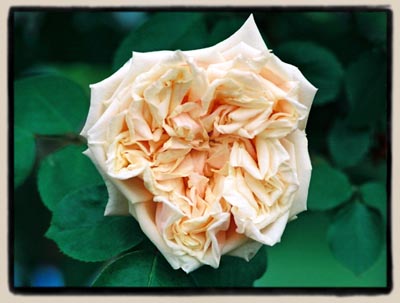 (includes
Ramblers) As mentioned above, if you have the option to train the long
canes on a trellis or fence, rather than having to cut them back, then
choose this. The long canes are going to be the basis of the climber's
structure, and you will want to make good use of these to help the rose
form its infrastructure. As the long canes shoot out their "laterals",
these side branches can be shortened to 3 or 4 bud eyes in February,
but only on the repeat blooming varieties! The true Ramblers, which
are only once-bloomers, should be left unpruned as much as possible. (includes
Ramblers) As mentioned above, if you have the option to train the long
canes on a trellis or fence, rather than having to cut them back, then
choose this. The long canes are going to be the basis of the climber's
structure, and you will want to make good use of these to help the rose
form its infrastructure. As the long canes shoot out their "laterals",
these side branches can be shortened to 3 or 4 bud eyes in February,
but only on the repeat blooming varieties! The true Ramblers, which
are only once-bloomers, should be left unpruned as much as possible.
At left:
'Gloire de Dijon', a Noisette climber.
Damasks:
These are all
once-bloomers, and as such, shoudl be pruned AFTER the bloom cycle is
finished. These are inherently graceful shrubs with good form, and are
often ruined by careless or over-zealous pruning. Removal of dead and
damaged wood, along with removal of spent blooms is sufficient. As the
shrub ages, twiggy growth at the center of the plant, and old unproductive
wood can be removed. The long new canes can be shortened to restrict
the shrub size if necessary, but only shorten by 1/3 at most, and do
it after blooming.
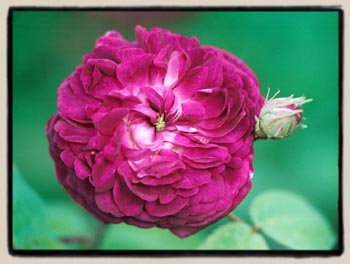 At
Right:
an unnamed
Gallica grown from seed. At
Right:
an unnamed
Gallica grown from seed.
Gallicas:
Remove dead or damaged
wood. Otherwise, these roses are best left unpruned for at least the
first 3 years of their lives. At that point, you can thin some of the
dense inner growth, if you really feel it is necessary. Some people
choose a rather radical treatment for the Gallicas once they are welll
established: every 3 years they cut the shrubs to a few inches tall
right after blooming is done! This forces these shrubs, which are thicket-forming
in nature, to regenerate themselves from the base up. I have yet to
try this myself, but I know many accomplished gardeners who do this,
with great success.
Hybrid Musks:
These are usually well-formed arching shrubs or small climbers,
and benefit from being trained horizontally to maximize blooms. They
are best left unpruned, except for prompt removal of spent blooms. This
encourages good repeat blooming. If in doubt, leave them alone.....they
know what shape they want to take!
Moss
Roses:
The Mosses are almost all variations on the Centifolias. Therefore,
prune only lightly, if at all. Remove any dead or damaged wood, and
as the shrub ages, remove the older less productive wood. There are
a few repeat-blooming varieties, which are essentially Mossy Damask
Perpetuals, and these need very little done, except to dead-head the
finished blooms. Avoid shortening the new, vigorous canes, as these
will determine the form of the shrub.
Noisettes:
These roses are
climbers, mostly. They resent hard pruning, and will perform to their
best ability if simply trained horizontally. The laterals (side shoots)
can be shortened to 1/3 their length in January or February if desired.
If in doubt, do nothing! Train them, don't prune! Many of these are
large climbers, like 'Reve d'Or',
and these make wonderful pillar roses, where they can be allowed to
climb up and cascade down in a fountain-like effect.
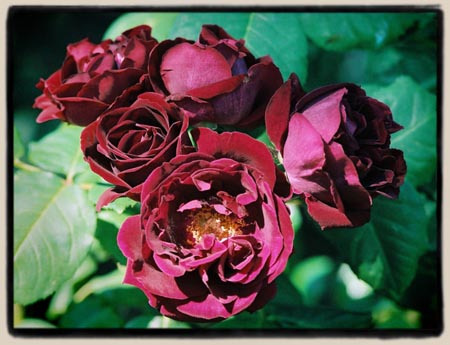 Hybrid
Perpetual: Hybrid
Perpetual:
The Hybrid Perpetuals are large, rampant roses that are ideal for
training as small climbers or for pegging down. The taller ones, such
as 'Souvenir du Docteur Jamain' produce long canes that are best trained
along a fence or on an arch. Some of the shorter, shrubbier ones, like
'Baronne Prevost' are best thinned
after blooming and left to form a large shrub.
At left: 'Souvenir
du Docteur Jamain', a climbing Hybrid Perpetual.
Rugosas:
I have often seen Rugosas pruned to force them into small rounded
shrubs, usually to poor effect. These roses resent hard pruning, and
doing so often destroys the shape of the mature plant. I advocate little
or no pruning, except to remove dead or damaged wood, and to remove
spent blooms on those varieties that do not set hips. One of the most
spectacular roses I have ever seen was a group of 3 plants of 'Hansa'
which were allowed to form 9 foot trees! They formed a beautiful canopy
of growth in an umbrella shape that was breathtaking. If you could have
seen these shrubs, you would understand why I say to leave them be!
Species:
Remove dead wood only!
Teas:
As with the China rose, the Teas are often slow to build up growth,
and are often twiggy and densely branched. It is important NOT to prune
these varieties in their first 3 years, except to remove dead wood and
spent blossoms. There are some climbing Teas, such as 'Sombreuil',
which should be treated as the climbing Bourbons, see above.
And
please remember not to believe everything you hear about pruning.....there
are some practices that have little or no basis in truth: you DON'T
need to seal the pruning cuts with glue or sealant. We prune thousands
of roses at the local rose garden and don't seal a single pruning cut,
and yet we don't see any disease or insect damage resulting from our
practices. There is no reason to believe that it makes the slightest
bit of difference whether or not you make the pruning cut at an angle
or not. They say it prevents moisture from staying on the cut surface.
Well, if you think about it, those cuts stay wet whenever there is rain
or dew, no matter what angle you cut at, so you can disregard that one
too. A little knowledge goes a long way with pruning.....and if you
are unsure about what you are doing, err on the side of NOT making the
cut!
Oh,
and by the way, buy yourself a good pair of Felco secateurs and good
leather gloves. Updating your tetanus shot isn't a bad idea either if
you haven't had one in 10 years.
This
website made possible by a grant from the
Uncommon Rose

There
have been  hits on this page. WebCounter does
the stats.
hits on this page. WebCounter does
the stats.
Original
photographs and site content © Paul Barden
1996-2003
|




 It
is getting to be that time of year again, and we have to get out there
and prune the roses. For me, however, it always seems like one of the
more joyful tasks of the year, likely because it signals the oh-so-tangible
arrival of SPRING!
It
is getting to be that time of year again, and we have to get out there
and prune the roses. For me, however, it always seems like one of the
more joyful tasks of the year, likely because it signals the oh-so-tangible
arrival of SPRING! 



 At
Right:
an unnamed
Gallica grown from seed.
At
Right:
an unnamed
Gallica grown from seed. Hybrid
Perpetual:
Hybrid
Perpetual: